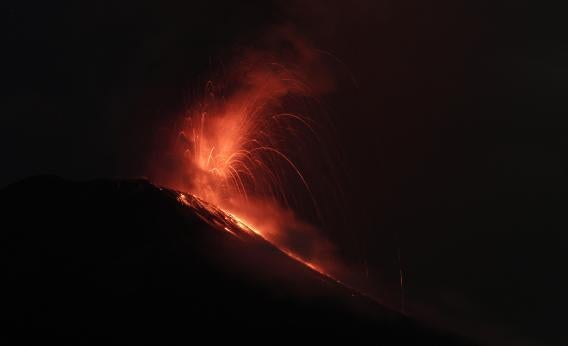A team of scientists plans to drill into the Earth’s mantle by the early 2020s. The pioneering mission is for scientific purposes, but it’s vaguely reminiscent of a plan hatched by Dr. Evil, Austin Powers’ buffoonish nemesis, to drill into the earth’s core, detonate a nuclear device, and trigger worldwide volcanic eruptions. Is there any chance that drilling deep into the Earth could cause a volcanic eruption?
No. Even if engineers were to drill directly into a reservoir of molten magma, a volcanic eruption would be extremely unlikely. For one thing, drill holes are too narrow to transmit the explosive force of a volcanic eruption. (It’s the equivalent of piercing a champagne cork with a pin rather than removing the entire cork at once.) In addition, if the hole is only 30 centimeters wide—the diameter of the planned borehole in the mantle drilling project—the small amount of magma that could flow into the shaft would solidify long before reaching the surface. Engineers have accidentally penetrated magma reservoirs several times. In 2008, drillers struck magma in Hawaii while attempting to find a geothermal energy source. Scientists did the same thing in Iceland seven months later. The magma usually destroys the drilling rig, but it doesn’t trigger an eruption. Scientists are even about to drill into an active volcano near Naples, Italy.
Humans could cause an eruption only in the most extreme and hypothetical circumstances. First, you’d need to find a magma reservoir that’s already on the verge of eruption. Most of the magma near Earth’s surface is a combination of solid, liquid, and gas that is too sludgy to burst violently out of the ground. In order to be “eruptable,” as volcanologists say, the reservoir must first be placed under intense, sustained pressure to liquefy the magma. Then, to trigger the eruption of a primed reservoir, a powerful explosive would have to very rapidly remove the rock above. It would also help to divert a river into the newly-opened chasm, since water increases eruptive force.
Dr. Evil may have been right about the need for a nuclear-strength explosive, but he got all the other details of his plot wrong. Drilling into the center of the Earth would have no effect on volcanos, which do not have a direct conduit to the molten core, as his diagram falsely suggested. Volcanic material comes from reservoirs no deeper than 30 miles underground. The core begins about 1,800 miles beneath the surface.
There’s another way humans might cause volcanic eruptions, but the process is very slow. British volcanologist Bill McGuire argues that human-induced climate change will redistribute water and ice weight across the Earth’s surface, changing the pressure on the stable magma reservoirs beneath and enabling eruptions. He points to significantly increased volcanic activity at the end of the last ice age about 12,000 years ago as evidence for a potential catastrophe. McGuire’s theory is controversial, however, and the effects wouldn’t be felt for decades or centuries in any event.
While drilling couldn’t cause the eruption of a true volcano, mud volcanoes are a different story. In 2006, a gas company pulled its drill bit out of an exploratory well in Indonesia, triggering a fracture in the rock that turned out to be holding back tremendous amounts of mud. (The company claims that an earthquake caused the eruption.) The Lusi mud volcano began spewing 100,000 tons of mud daily, quickly covering three square miles of land in 65 feet of sediment. The eruption has continued to this day, and some scientists predict the flow could last more than 80 years.
Got a question about today’s news? Ask the Explainer.
Explainer thanks Erik Klemetti of Denison University, author of Wired’s Eruptions blog.
Video Explainer: Does Heroin Usually Have a Brand Name?
